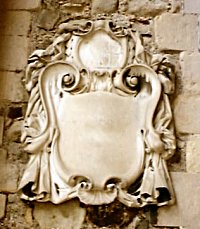On the North wall of the nave, to the south of the aisle.
This memorial is in very poor condition and only partially legible. The inscription is taken from the 1874 guide.

LYETH THE BODY OF
COLONEL PETER HAWKER
LATE LIEUT-GOVERNOR OF PORTSMOUTH
WHO DEPARTED THIS LIFE
5TH DAY OF JANUARY 1732
IN THE 60TH YEAR OF HIS AGE
THE ABOVE TABLET WAS REPAIRED IN 1838
BY HIS GREAT GRANDSON
COLONEL PETER HAWKER
Further Information
Peter Hawker was born in 1673 and married Elizabeth Hyde in 1698 in Morpeth, Northumberland. In 1715 he is recorded as being Lieut. Colonel in the Dragoons. Two years later he took up the post of Governor of Portsmouth. He resided in Longparish, Hants. where he died on 5 Jan 1732.
The Great Grandson who restored the tablet was Peter Hawker, army officer and writer, born on 24 December 1786, the son of Colonel Peter Ryves Hawker (d. 6 Feb 1790) of Longparish, Hampshire, and his wife, Mary Wilson Yonge, who was of an Irish family. He was born in London and educated at Eton College. Like his father and many of his ancestors Hawker entered the army, his commission as cornet in the 1st (Royal) Dragoons dating from 1801. In 1803 he joined the 14th light dragoons, in which regiment he became captain the following year and served with it in the Peninsular War. Being badly wounded at Talavera, he retired from active service in 1813, but by the recommendation of the duke of Clarence he was made major (1815) and then lieutenant-colonel (1821) of the North Hampshire militia.
Hawker, a man of wide interests, was a good musician as well as a keen shot and active sportsman. In 1818 he studied harmony and composition at the London academy of J. B. Logier, and in 1821 was a piano student of H. J. Bertini in Paris. He composed much music, and in 1820 patented his invention of hand moulds to facilitate pianoforte playing. At the Great Exhibition of 1851 some improvements in firearms manufacture which Hawker devised attracted attention, and he hoped in vain that they would be adopted by the War Office.
Hawker was twice married, and with his first wife, Julia, daughter of Hooker Bartellot, whom he married in 1811, he had two daughters and a son, Peter William Lanoe Hawker, who served as a lieutenant in the 74th Highland regiment.
Hawker's publications included Journal of a Regimental Officer during the Recent Campaign in Portugal and Spain (1810) and Instructions to Young Sportsmen in All that Relates to Guns and Shooting (1814). This work, by which Hawker became widely known, passed through many editions. Hawker died at 2 Dorset Place, Dorset Square, London, on 7 August 1853.
[Adapted from the entry in the Oxford Dictionary of English Biography by W. A. J. Archbold, rev. James Falkner]
